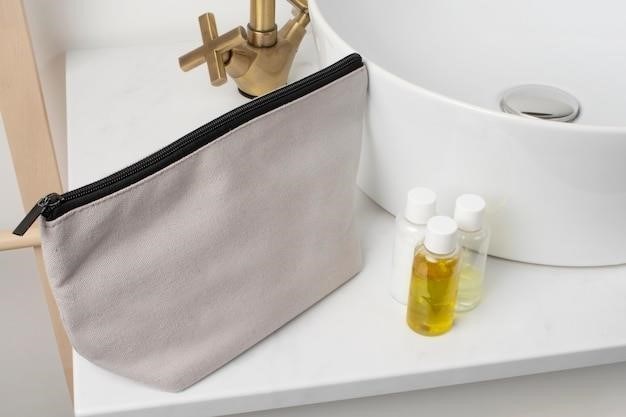Zippered Pouch Tutorial⁚ Flat Bottom
This tutorial will guide you through making a sleek zippered pouch with a flat bottom. It’s a fun and easy sewing project that you can complete in a few hours. You can use this pouch to store your sewing notions, makeup, or anything else you need to keep organized.
Introduction
Welcome to this comprehensive guide on crafting a stylish and functional zippered pouch with a flat bottom! This tutorial is perfect for beginners and experienced sewers alike, offering clear instructions and helpful tips to ensure a successful project. Creating a zippered pouch is a rewarding experience, allowing you to personalize your accessories with your favorite fabrics and designs. The flat bottom feature adds a touch of sophistication and practicality, making it ideal for holding various items, from sewing notions to makeup essentials.
This project is also an excellent way to use up fabric scraps and practice your sewing skills. By following this step-by-step guide, you’ll learn how to sew a zipper, create a flat bottom, and add a pocket (optional), all while mastering essential sewing techniques. So, gather your materials, get your sewing machine ready, and let’s embark on this exciting journey of crafting a beautiful and useful zippered pouch!
Materials Needed
Before you begin sewing your zippered pouch, make sure you have all the necessary materials. This will ensure a smooth and enjoyable crafting experience. Gather the following items to get started⁚
- Fabric⁚ Choose your favorite fabrics for the exterior and lining of your pouch. Consider using cotton, linen, or canvas for durability. You will need two pieces of fabric measuring 9 x 7 inches each for the exterior and two pieces measuring 9 x 7 inches each for the lining.
- Zipper⁚ Select an 8-inch closed-end zipper. The zipper tape should measure 9.5 inches, but from zipper stop to zipper stop, it should be 8 inches. For added color and style, consider using a colorful zipper set.
- Fusible Interfacing⁚ This will provide structure and stability to your pouch. You will need two large pieces measuring 9 x 7 inches each and one smaller piece measuring 9 x 5 inches.
- Thread⁚ Choose coordinating thread colors for your exterior and lining fabrics.
- Sewing Machine⁚ A sewing machine is essential for this project.
- Zipper Foot⁚ This specialized foot helps you sew close to the zipper teeth for a neat finish.
- Scissors⁚ Sharp scissors for cutting your fabric and interfacing.
- Pins or Clips⁚ For holding fabric pieces together while sewing.
- Iron⁚ For pressing seams and interfacing.
- Measuring Tape⁚ For accurately measuring your fabric pieces.
- Rotary Cutter and Mat (optional)⁚ For precise and efficient fabric cutting.
With these materials in hand, you’re ready to dive into the exciting world of crafting your personalized zippered pouch!
Cutting the Fabric
Now that you’ve gathered your materials, it’s time to cut your fabric pieces to the correct size. This step is crucial for ensuring a well-proportioned and neatly finished pouch. Use your measuring tape and scissors or rotary cutter and mat for precise cutting. Here’s a breakdown of the fabric pieces you’ll need to cut⁚
- Exterior Fabric⁚ Cut two pieces measuring 9 x 7 inches each. These will form the outer sides of your pouch.
- Lining Fabric⁚ Cut two pieces measuring 9 x 7 inches each. These will form the inner sides of your pouch.
- Pocket Fabric⁚ Cut one piece measuring 9 x 5 inches for the main pocket.
- Pocket Flap Fabric⁚ Cut one piece measuring 4 x 5 inches for the pocket flap.
- Pocket Lining Fabric⁚ Cut one piece measuring 5.5 x 5 inches for the lining of the pocket flap.
- Loop Fabric (optional)⁚ Cut one piece measuring 2 x 3 inches for a loop on the side of the pouch. This adds a decorative touch and can be used to attach a charm or key ring.
Once you’ve cut all the fabric pieces, set them aside and prepare for the next step⁚ fusing the interfacing to your fabric. This will give your pouch structure and prevent it from sagging.

Sewing the Zipper
Now comes the exciting part – attaching the zipper to your pouch! Take your 8-inch zipper and one of the lining fabric pieces. Position the zipper tape (the flat fabric portion) on the edge of the lining piece, with the wrong side of the zipper facing the right side of the fabric. Use pins or clips to secure the zipper in place. Make sure the zipper is lying flat and smooth along the edge of the fabric, ensuring you won’t encounter any bumps or creases while sewing.
Attach your zipper foot to your sewing machine. This specialized foot helps you sew along the zipper tape with precision. Sew along the zipper tape, guiding your needle close to the edge of the zipper coil, but avoid sewing too close to prevent catching the coil. This will create a secure and neatly finished seam.
Repeat this process on the other side of the zipper, attaching the remaining lining fabric piece to the other zipper tape. You’ve now successfully attached both sides of your zipper to the lining fabric. Remember to double-check that your stitches are secure and the zipper glides smoothly.
Now, move on to the next step⁚ creating the pocket for your pouch. This will add functionality and a touch of style to your project.
Creating the Flat Bottom
To give your pouch a sturdy and functional flat bottom, we’ll be creating “boxed corners.” This technique adds structure and prevents the pouch from slumping over. It might seem a bit tricky at first, but it’s quite simple once you get the hang of it.
First, take your outer fabric pieces and your lining pieces. At the bottom corners of each of these pieces, cut out a 1.5 x 1.5 inch square. This will create the opening for your boxed corners. Now, fold one corner of the pouch, right sides together, ensuring the seams align. The cut edges will be facing each other, creating a triangle shape. Pin or clip these edges securely together.
Using your sewing machine, stitch along the 1.5-inch edge of the folded corner, creating a seam that closes the triangle. This forms one side of your boxed corner. Once stitched, carefully cut a small slit into the corner point to allow the seam allowances to open up. Repeat this process for all four corners of both the outer fabric and the lining fabric. You’ve now created the boxed corners that will give your pouch its flat bottom.
Next, we’ll be attaching the pocket, a simple yet essential addition for your pouch. This step will add extra storage space and enhance the overall design.
Attaching the Pocket (Optional)
Adding a pocket to your zippered pouch is a great way to add extra functionality and organization. It’s a simple addition that can be customized to your needs. You can choose to include a pocket or skip this step entirely, depending on your preference. If you’re opting for a pocket, let’s get started!
First, gather your fabric pieces for the pocket⁚ piece C (9 x 5 inches) and piece D (4 x 5 inches). Place these pieces right sides facing each other, aligning one of the 5-inch edges. Sew these pieces together along the aligned edge, using a 3/8-inch seam allowance. Once sewn, press the seam open with your iron, ensuring a neat finish. This creates the base of your pocket.
Now, grab the smallest interfacing piece, which is designed to reinforce the fabric and prevent it from stretching or tearing. Center this interfacing piece on the backside of the inner pocket piece (B) and carefully fuse it to piece B using a hot iron. You can also choose to fuse it to the newly sewn piece (C and D) for extra stability. To protect your iron’s sole, using a non-stick sheet when ironing fusible interfacing is highly recommended. This sheet allows heat to pass through while preventing any glue from the interfacing from sticking to your iron.
With the interfacing secured, place the pocket piece (B, C, and D) right sides facing on the fabric piece you’ve designated for the exterior of your pouch. Align the edges carefully and pin them together. Sew one of the long sides together, ensuring this sewn edge will become the top of your pocket. Press the seam open on the wrong side, creating a clean fold. Fold the two pieces together on the seam, right sides out, and press again to enhance the shape of the pocket.
Finishing Touches
You’re almost there! The pouch is taking shape, and now it’s time to add the finishing touches that will make it truly special. These details will elevate your project from a basic zippered pouch to a polished and professional piece you’ll be proud to use and show off.
First, let’s tackle the zipper. Ensure the zipper is unzipped and lay it flat. Now, carefully sew along the long edges and short edges of the pouch, using a 1/2 inch seam allowance. Leave a small opening in the lining section, as shown in the instructions. This opening will be used to turn the pouch right side out later.
To create the flat bottom, we’ll box the corners. Fold one corner of the pouch (right sides together) with seams matching, and stitch along the folded edge. Cut into the point of the corner to allow the seam allowances to open up. Repeat this process for each corner, creating a neat and sturdy base for your pouch.
If you’ve chosen to add a loop or a tag, now is the time to attach it. Fold the small fabric piece in half, lengthwise, right sides facing. Stitch the long edge closed. Turn the tube right side out and iron it flat. Double fold and pin or clip it to the side of the outer fabric, aligning the edges. Baste stitch the loop close to the edge, securing it firmly in place.
Turning the Pouch Right Side Out
With all the stitching complete, it’s time to reveal your beautiful pouch. The moment of truth is here! Carefully turn the pouch right side out through the opening you left in the lining. This might feel a little tricky at first, but with a little patience, you’ll get it.
Once you’ve turned the pouch, you might notice that it’s still inside out. Don’t worry, this is normal! Now, you’ll turn it right side out again through the zipper opening. This will ensure that the lining is neatly tucked inside.
Now comes the fun part ― shaping those corners! Using an awl or a magic wand, gently push out the corners to create a crisp and defined shape. This little detail will give your pouch a polished look. Finally, iron the pouch flat, pressing carefully to smooth out any wrinkles and create a professional finish.
Take a moment to admire your handiwork. You’ve successfully turned your pouch right side out, and it’s looking fantastic. You’re just one step away from completing your project!

Closing the Turning Hole
The final step in this tutorial is closing the turning hole in the lining. This little detail will make your pouch look professional and give it a clean finish. You can use a variety of hand stitches to close the hole, but a ladder stitch is a popular choice for its invisibility. If you’re not familiar with the ladder stitch, there are plenty of helpful tutorials available online that can guide you through the process.
To close the hole, carefully fold the edges of the fabric together, ensuring that the raw edges are aligned. Then, using a needle and thread that matches the lining fabric, begin stitching along the edge of the hole. The ladder stitch is a simple stitch that creates a neat, invisible seam. Simply insert the needle through both layers of fabric, then pull the thread through. Repeat this process, working your way along the edge of the hole.
As you stitch, be sure to keep the stitches small and even. This will ensure that the seam is strong and secure. When you reach the end of the hole, tie off the thread securely, ensuring that the knot is hidden within the seam.
Once you’ve closed the turning hole, admire your finished pouch. It’s time to put your new pouch to the test and enjoy the fruits of your labor.
Congratulations! You have successfully completed this zippered pouch tutorial and now have a handy, flat-bottomed pouch that you can use for a variety of purposes. This project is great for beginners and provides a rewarding sense of accomplishment. As you become more confident with your sewing skills, you can experiment with different fabrics, embellishments, and designs to personalize your pouches.
Remember, there are countless variations you can explore with this basic design. Try adding a gusset to the bottom to create a more spacious pouch, or experiment with different zipper sizes and styles to create unique looks. You can also add pockets, straps, or even a small handle for a more functional pouch. The possibilities are endless!
Sewing your own zippered pouches is a fun and practical way to organize your belongings and showcase your creativity. Don’t be afraid to experiment and let your imagination run wild. Enjoy the process and the satisfaction of creating something beautiful and useful with your own hands.



